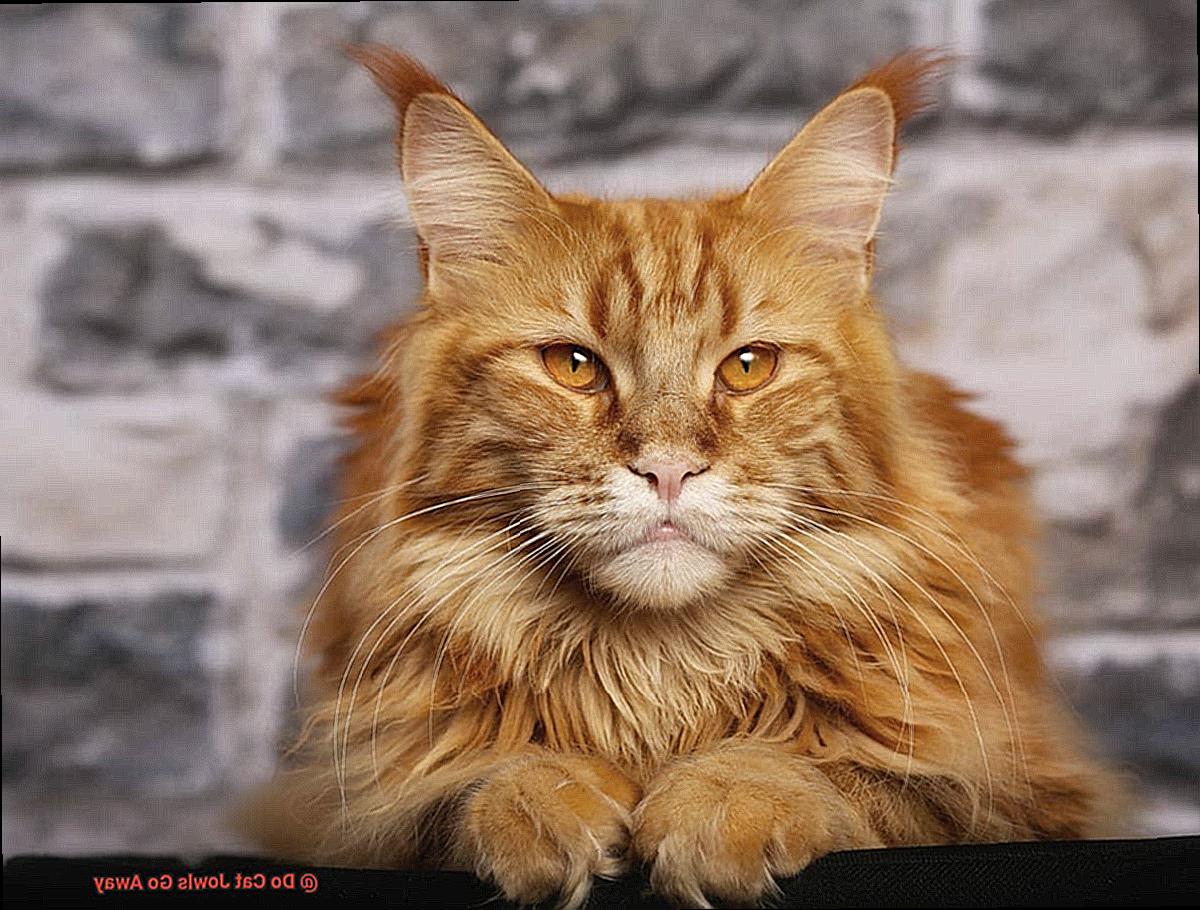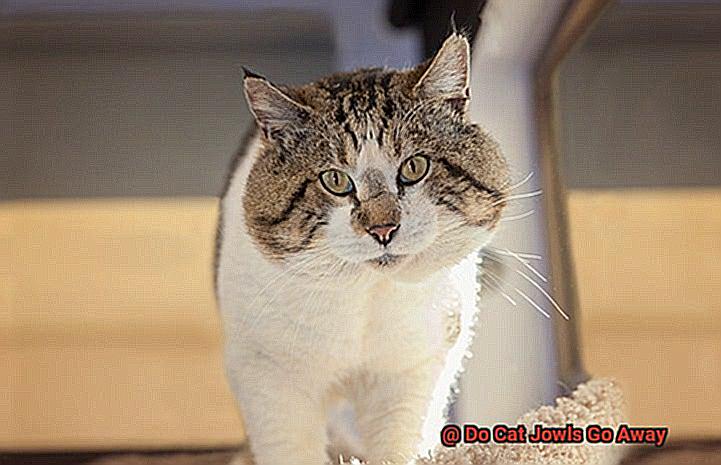Are you a cat lover who can’t resist the charm of those adorable jowls that adorn your furry friend’s face? Cat jowls are more than just a cute feature, they are also a subject of curiosity and fascination among pet owners. But have you ever wondered if these fleshy folds go away as cats age or lose weight?
The truth is, cat jowls are not just a temporary fixture on your feline friend’s face. These fatty tissues under their chin are actually part of their anatomy and will remain a permanent feature. While they may shrink slightly over time or with weight loss, they will never completely disappear.
But why do cats have jowls in the first place? It is believed that these fleshy folds may have evolved to protect a cat’s throat during hunting or to help them communicate with other cats. Regardless of their evolutionary purpose, one thing is for sure – cat jowls add to the unique and fascinating nature of our beloved pets.

So, if you’re a curious cat owner wondering about the origins and permanence of your cat’s jowls, rest assured that your furry friend will continue to rock them for years to come. After all, it’s just another reason why we can’t get enough of these amazing creatures.
Causes of Cat Jowls
While they might look endearing in some cases, they can also be indicative of underlying health issues or obesity. In this article, we’ll explore the different causes of cat jowls and the ways to manage them.
One of the most common causes of cat jowls is weight gain. Cats, like humans, can accumulate fat deposits in their bodies, which often manifest as jowls. This is particularly true for older cats who tend to be less active and have slower metabolisms. Fortunately, keeping an eye on your cat’s diet and exercise routine and promoting a healthy weight can help reduce the appearance of jowls.
Another reason for cat jowls is genetics. Some breeds, such as the Maine Coon, are more prone to developing jowls due to their facial structure. However, not all Maine Coons will develop jowls, and other breeds may also have them due to genetic predisposition. Be sure to monitor your cat’s chin area for any signs of swelling or drooping if they belong to a breed known to develop jowls.
Sometimes, cat jowls may indicate an underlying health issue. For instance, an overactive thyroid gland can cause weight loss in other parts of the body but an increase in fat accumulation in the neck and jowl area. Dental issues or gum disease can also cause inflammation and swelling in the mouth, leading to the appearance of jowls. If you notice any unusual changes in your cat’s chin area, it’s best to seek advice from your veterinarian to rule out any underlying health concerns.

Lastly, aging is another factor that can contribute to the development of cat jowls. As cats age, their skin loses elasticity and collagen, causing sagging and drooping around the jawline. Although this is a natural part of aging, there are ways to manage the appearance of jowls, such as weight management and medical interventions.

Do Cat Jowls Go Away?
Unfortunately, the answer is no. These saggy or droopy cheeks are frequently seen in larger breeds like Maine Coons and are caused by genetics and aging. This means they may become more pronounced as cats get older.
But don’t worry, there are things you can do to help reduce the appearance of cat jowls. One of the best ways is to maintain your cat’s healthy weight through a balanced diet and regular exercise. This will help prevent excess fat from accumulating in the jowl area.

Another solution is to groom your cat regularly and keep their fur trimmed around the face. This can create the illusion of a more defined jawline, making their jowls seem less noticeable.
If these methods do not work, you can consider surgical intervention. However, it’s essential to talk to your veterinarian first and weigh the potential risks and benefits.
Weight Management for Cat Jowls
Excess weight can contribute to saggy cheeks, but the good news is that there are ways to manage your feline friend’s weight and improve their appearance.
Healthy nutrition is crucial when it comes to weight management. Feeding your cat a high-quality diet that is appropriate for their age, activity level, and overall health can help maintain a healthy weight. It’s important to measure out portions and avoid overfeeding, as this can lead to weight gain and contribute to the appearance of jowls.
Exercise is also a key aspect of weight management. Encouraging your cat to play with toys or engaging in interactive playtime can help increase their activity level and promote weight loss. Not only will this help reduce the appearance of jowls, but it will also boost their overall health and well-being.
It’s important to go about weight loss in a healthy and gradual manner as rapid weight loss can harm your cat’s health. Consulting with a veterinarian is recommended when addressing weight management. They can provide guidance on appropriate nutrition and exercise routines for your cat’s individual needs. They may also recommend a gradual weight loss plan and monitor your cat’s progress to ensure it is done safely.
Medical Interventions for Cat Jowls
Luckily, medical interventions are available to help reduce the size of cat jowls.
The first intervention is weight loss, a non-surgical option that can be effective in reducing the size of jowls in overweight cats. However, it’s essential to consult with a veterinarian before starting a weight loss program as it needs to be done gradually and safely. Your furry friend’s health should always come first.
If weight loss alone fails to improve the appearance of your cat’s jowls, surgical interventions may be necessary. Liposuction involves removing excess fat from the jowl area through small incisions, while a facelift can tighten the skin around the jowl area and create a more youthful appearance.
It’s crucial to note that all surgical interventions come with risks and should only be performed by a qualified veterinarian or veterinary surgeon. Additionally, it’s crucial to follow post-operative care instructions carefully to ensure proper healing and minimize the risk of complications. Your cat deserves the best care possible.
Potential Risks of Procedures to Reduce Jowls
Before making any hasty decisions, it’s essential to understand the potential risks involved in surgical or non-surgical procedures. As an expert in this field, I’m here to provide you with all the necessary information you need to make an informed decision.
Surgical procedures like facelifts or liposuction can pose severe risks to your cat’s health and well-being. One of the most significant risks associated with these procedures is anesthesia. Cats are prone to respiratory problems, and administering anesthesia can lead to breathing difficulties. Additionally, cats may experience complications such as bleeding, infection, or allergic reactions to the anesthesia.
Non-surgical procedures like laser therapy or ultrasound may also carry potential risks. Laser therapy involves using laser energy to stimulate collagen production in the skin around the jowls. However, if not performed correctly, laser therapy can cause burns or scarring. Similarly, ultrasound uses high-frequency sound waves to heat and tighten the skin, but if not calibrated correctly, it may cause tissue damage or burns.
It’s crucial to note that all procedures come with some degree of risk. Therefore, it’s vital for owners to weigh the potential risks against the benefits before deciding to pursue any type of treatment for their cat’s jowls. Consulting with a veterinarian is always a good idea before proceeding with a procedure.
Improving Your Cat’s Quality of Life with Jowl Management
However, certain breeds such as Maine Coons may develop jowls that can cause discomfort or health issues. Fortunately, there are effective ways to manage your cat’s jowls and improve their quality of life.
One of the most important aspects of jowl management is maintaining proper grooming habits. Regular brushing around the jowls can prevent matting and tangling of fur, which can lead to skin irritation and infection. Keeping the area clean and dry is also crucial to avoid any bacterial growth.
In addition to grooming, maintaining a healthy weight is key to managing your cat’s jowls. Excess body fat can put pressure on the jowls and exacerbate any discomfort or health issues. Providing your cat with a balanced diet and encouraging physical activity can help them maintain a healthy weight and reduce strain on their jowls.
Depending on your cat’s specific needs and health status, specialized diets or supplements may be recommended to address specific concerns related to their jowl size or shape. If your cat has difficulty chewing due to their jowls, soft or wet food may be easier for them to eat. Alternatively, supplements like glucosamine and chondroitin can help support joint health and improve mobility.
It’s important to keep in mind that every cat is unique, so consulting with your veterinarian can provide valuable guidance and recommendations for optimizing your cat’s quality of life. With proper care and attention, you can help ensure that your feline friend remains happy and comfortable despite any challenges posed by their jowls.
0sRRhwTxUAI” >
Also Read: Why Do Cats Rub Their Teeth On You?
Conclusion
In conclusion, cat jowls are a permanent part of a cat’s facial structure and cannot be completely eliminated. However, they may reduce in size with weight loss or over time. While cat jowls can add to the charm of our feline friends, they can also indicate underlying health issues or obesity. It is crucial to keep an eye on your cat’s chin area for any swelling or drooping and seek veterinary advice if necessary.
One effective way to minimize the appearance of cat jowls caused by excess weight is through weight management via a balanced diet and regular exercise. Additionally, grooming your cat regularly and trimming the fur around their face can create an illusion of a more defined jawline. If non-surgical options prove ineffective, surgical interventions such as liposuction or facelifts may be considered but should be weighed against potential risks.
Ultimately, managing your cat’s jowls is about enhancing their quality of life. Maintaining healthy habits such as proper grooming practices, providing specialized diets or supplements when necessary, and consulting with a veterinarian can ensure that your furry friend remains happy and comfortable despite any challenges posed by their jowls.







